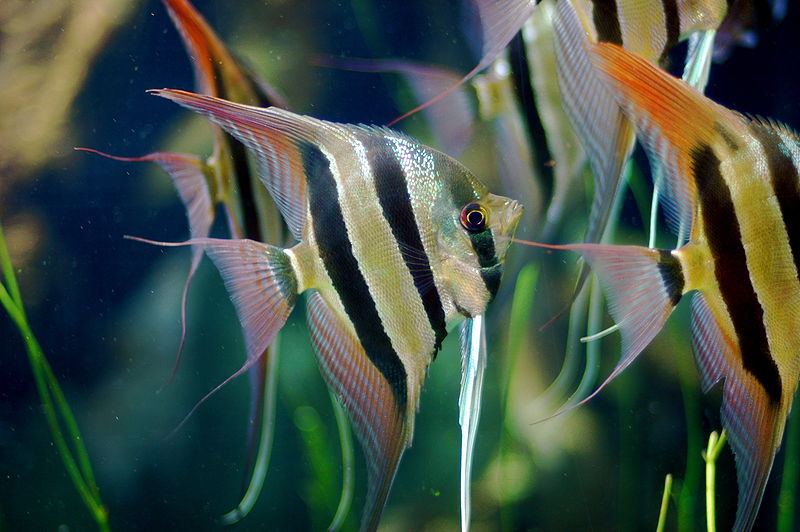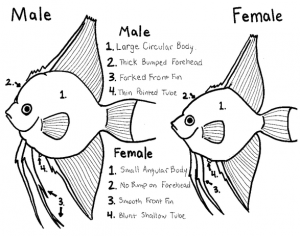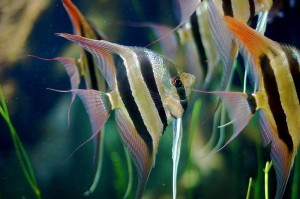
Common Name(s) : Angelfish
Family : Cichlidae
Subfamily : Cichlasomatinae
Tribe : Heroini
Genus : Pterophyllum
Species : Pterophyllum altum
Origin : South America
PH : 6.0 – 7.5
Hardness : Soft to Moderately Hard
Temperature : 24 – 26°C / 75.2–78.8 °F
Maximum Size : 15cm / 6 inches
Lifespan : 10 years
Aggression Level : Medium (5/10) (Small fish cannot be kept with larger specimens)
Recommended Tank Size : 60 Litres +
Strata : Middle
TANK SET UP
Enjoy a planted aquarium with a few hidey holes such as rocks, driftwood or ornaments. Not overly fussy however. A piece of slate is commonly added for those aquarists who wish to breed their Angels.
SUITABLE TANK MATES
- Medium-sized Tetras (not Neons)
- Tropical Fish
- Dwarf Cichlids
DIET
Pellets; Flake; Bloodworms; Brineshrimp
SEXING AND BREEDING
 Sexing Angelfish can be tricky, but not impossible. Males feature a more circular body, a very slight bumped forehead, forked front fins and a thinner pointed tube down below.
Sexing Angelfish can be tricky, but not impossible. Males feature a more circular body, a very slight bumped forehead, forked front fins and a thinner pointed tube down below.
Females are commonly smaller and feature an angular body shape, no slight bump on the forehead, smooth front fins and a blunter, shorter tube down below.
We often get Angelfish breeding in our store; after spending time together swimming around “as a couple” the two lovebirds will mill off to a quiet corner somewhere in the aquarium and begin cleaning a suitable smooth location such as the surface of glass wall, a leaf of a plant or even the heater.
After hours or even a day of this, the female will glide forward over the area laying the eggs in a line with the male following close behind fertilizing. Its a beautiful thing to watch, it takes about an hour usually.
The following 5 days are spent by the two parents guarding the eggs from curious tank mates and fanning the eggs with their fins to prevent the eggs turning fungal. After about 5 days the eggs hatch, and for the preceding 4-5 days the young wrigglers will feast on their egg sacks while staying in close proximity to their birth area.
After 5 days the wrigglers will spread out in the search for food. Small amounts of Baby Brine Shrimp can be fed periodically through the day, maybe 3 times a day. Plants can be added to create a “wall” of protection for the fry to keep other community fish at bay and to lessen the chance of the parent Angels attacking other fish.
OTHER USEFUL INFORMATION
Types of Angelfish:
Silver
- The silver angelfish most commonly resembles the wild form of angelfish, and is also referred to as “wild-type”. It is not, however, caught in the wild and is considered domestic. The fish has a silver body with red eyes and three vertical black stripes that can fade or darken depending on the mood of the fish.
Gold
- The genetic trait for the gold angelfish is recessive, and causes a light golden body with a darker yellow or orange color on the crown of the fish. It does not have the vertical black stripes or the red eye seen in the wild angelfish.
Zebra
- The zebra phenotype results in 4 to 6 vertical stripes on the fish that in other ways resembles a silver angelfish. It is a dominant mutation that exists at the same locus as the stripeless gene.
Black Lace
- A Silver or Zebra with one copy of the Dark gene. This results in very attractive lacing in the fins. Considered by some to the most attractive of all angelfish varieties.
Smokey
- A variety with a dark brownish grey back half and dark dorsal and anal fins.
Chocolate
- Homozygous for Smokey with more of the dark pattern. Sometimes only the head is silver.
Halfblack
- Silver with a black rear portion. Halfblack can express along with some other color genes, but not all. The pattern may not develop or express if the fish are in stressful conditions.
- The Sunset Blushing has two doses of gold and two doses of Stripeless. The upper half of the fish exhibits orange on the good ones. The body is mostly white in color, fins are clear. The amount of orange showing on the fish can vary. On some the body is a pinkish or tangerine color. The term blushing comes from the clear gill plates found on juveniles. You can see the pinkish gill underneath.

- The Koi has a double or single dose of Gold Marble with a double dose of Stripeless. They express a variable amount of orange that varies with stress levels. The black marbling varies from 5%-40% coverage.
Leopard
- The leopard is a very popular fish when young, having spots over most of their body. Most of these spots grow closer together as an adult so it looks like a chocolate with dots on it. (Smokey x Zebra)
Blue Blushing
- This is a wild-type angelfish that has two Stripeless genes. The body is actually grey with a bluish tint under the right light spectrum. An iridescent pigment develops as they age. This iridescence usually appears blue under most lighting.
Silver Gold Marble
- A Silver angel with a single Gold Marble gene. This is a co-dominant expression of Silver and Gold Marble, so you see traits of both.
Ghost
- A fish that is heterozygous for Stripeless. This results in a mostly silver fish with just a stripe through the eye and tail. Sometimes portions of the body stripes will express.
Gold Marble
- A gold angel with black marbling. Depending on whether the Gold Marble is single or double dose, the marbling will range from 5% to 40% coverage.

Marble
- Marble expresses with much more black pattern than Gold Marble does. The marbling varies from 50% to 95%.
Black Hybrid
- Cross a black with a gold, and you get black hybrids. A very vigorous black, that may look brassy when young. Does not breed true.

Pearlscale
- Pearlscale is a scale mutation. The “pearlscale” angelfish is also called the “diamond” angelfish in some regions due to the gem-like iridiscence on its scales. The scale have a wrinkled, wavy look that reflect light to create a sparkling effect. Pearl develops slowly, starting at around 9 weeks of age. In can be inhibited by stressful conditions. It is recessive, requiring both parents to contain the allele. It looks best on light colored fish like Gold, Gold Marble, Albino, Silver and Zebra. It is difficult to see on dark fish and blushing angelfish.
Black Ghost
- Same description as a Ghost, with a darker appearance due to the Dark gene. Very similar to a Black Lace without complete stripes. Ghosts generally have more iridescence than non-ghosts.
Albino
- Albino removes dark pigments in most varieties. Some, like Albino Marble will still have a little black remaining on a percentage of the fish. The eye pupils are pink as in all albino animals. The surrounding iris can be red or yellow depending on the variety of Albino.
VIDEO


Leave a Reply
You must be logged in to post a comment.